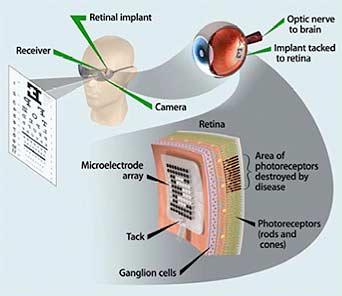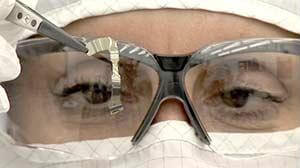
Restoring vision to the blind is one of the epic promises of technology, sort of like flying cars, ray guns, and a lovable robot side kick. Yet artificial sight isn’t a far off dream, it’s getting much closer to reality with the Argus project. Funded by the US Department of Energy and lead by Lawrence Livermore National Labs, Argus seeks to create an epiretinal prosthesis, a device that will take the image from a camera and send it to your brain via your optic nerve. The first two phases of Argus (which we call Argus I and Argus II) have had extraordinary success with implants in more than 30 patients. Now, LLNL is getting ready to launch Argus III – the third phase that will expand the number of patients, the quality of vision provided, and ease in which the device is implanted. The Argus project has already restored sight to a few blind people, but given enough time, it could change the lives of millions.
There are other epiretinal prosthesis in development. The one at MIT is particularly promising. Yet Argus is at the forefront of the field. It should be considering the resources: 5 US national labs, four major universities, a growing private company, and millions in funding. With all this effort, the DOE hopes that retinal implants will be a meaningful solution for the 25 million people around the world who have lost their vision due to retinal problems (such as macular degeneration and retinitis pigmentosa). Right now Argus (and all such projects) are struggling just to match human capabilities. Beyond that point, however, artificial retinas open the prospect of cybernetic vision. Giving sight to the blind is just a few steps short of improving the vision of the sighted, or even giving everyone eyes that put Superman’s to shame.

Of course, we’re not there quite yet, and no one’s even talking about cybernetic vision at LLNL. Argus III is a meaningful step along the same path established by Argus I and Argus II. In Argus I, it took patients about 15 seconds to recognize objects using the retinal implant. In Argus II that was down to 2-3 seconds. Argus I had implants that provided 16 pixels of resolution. Argus II got up to 60, enough for the edges of doors, or the shape of a building. According to images from the LLNL site, the current implants prepared for Argus III will have 200+ pixels. The DOE eventually wants 1000 pixels, at that point you could reliably make out someone’s face.

Improving the pixel count isn’t easy as it depends on the number of electrodes that get attached to the retina. The Argus device works by taking a thin-film electrode array and surgically implanting it onto the retinal tissue. These electrodes communicate wirelessly with an external camera through a biocompatible electronics package that is attached to the array. The entire assembly is smaller than it sounds and fits within the ocular cavity. Increasing the resolution of Argus means placing more electrodes on that array, as well as developing the electronics package that can handle the signal and processing. Not easily done, but every phase of Argus has improved in that direction.
At the moment, LLNL and associated researchers are focusing on getting the electronics of Argus III up to snuff. Human trials haven’t started yet, but we’ll let you know when they do. Considering the size of Argus I and Argus II, you can bet that dozens of patients will receive a chance to try the newest retinal implant.
Which does bring up an important issue about this entire line of research. Artificial retinas require surgery. As we discussed with the MIT implant, there are ways of minimizing the risks associated with such surgeries, but they can’t be brought to zero. Placing a thin film electrode array on the retina has some chance of causing it further damage. There are non-surgical solutions to producing a retinal implant, we’ve even seen a device that places the electrode array on the tongue! Still, for those wishing to replicate human vision, a device permanently embedded in the eye would seem like the ultimate solution.
Looking at the improvement in resolution (16 pixels to 60 to 200+) it’s hard not to hope for a geometric trend. At this rate, Argus IV may reach the DOE’s 1000 pixel goal, and Argus V could vastly exceed it. However, I would rather be cautiously optimistic than wildly hopeful. The Argus project is a remarkable scientific endeavor and I am really encouraged by the steady work done at LLNL and partnered facilities. Still it’s relatively early in the development of the prosthesis and it could be many more years before such technology is widely available to the general public.
But you know, looking at that implant, knowing the exponential growth of processing speed and transistor technology, I can’t help but think that we’re just a few short steps from cybernetically enhanced vision. How many decades (if that long) before we have to choose between keeping our natural eyes and opting for superior machine vision? It’s just an epic promise of technology at this point…but some of those promises could be fulfilled. One step at a time.
[image credits: Lawrence Livermore National Labs]


